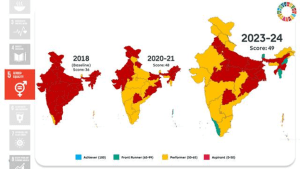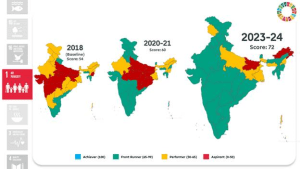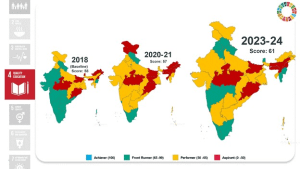TAG: GS 2: GOVERNANCE
THE CONTEXT: Kerala and Uttarakhand have emerged as the top-performing states in NITI Aayog’s SDG India Index 2023-24, while Bihar remains the worst performer.
EXPLANATION:
- The SDG India Index evaluates the progress of Indian states based on the United Nations’ Sustainable Development Goals (SDGs).
- India’s SDG score improved significantly, highlighting advancements in various developmental areas.
Overall Improvement in India’s SDG Score
- India’s SDG score rose to 71 points in 2023-24 from 66 points in 2020-21.
- This improvement is attributed to significant progress in poverty reduction, economic growth, and climate action.
- The index assesses performance across 16 goals using 113 indicators, providing a comprehensive view of each state’s development.
- Top and Bottom Performing States
- Top Performers:
- Kerala and Uttarakhand: Both states scored 79 points, leading the index.
- Bottom Performers:
- Bihar: Scored 57 points, the lowest among all states.
- Jharkhand: Scored 62 points, the second-lowest.
- States Showing Highest Improvement
- Punjab, Manipur, West Bengal, and Assam:
- These states recorded the highest increase of 8 points, reaching scores of 76, 72, 70, and 65 points, respectively.
- Punjab, Manipur, West Bengal, and Assam:
- Top Performers:
Government Intervention and Progress
- NITI Aayog CEO emphasized that targeted government interventions have significantly improved the performance across 16 SDGs.
- These goals are interconnected and aim for global achievement by 2030.
- Performance Across Individual SDGs
- Highest Increase in Points:
- No Poverty
- Decent Work and Economic Growth
- Life on Land
- Smallest Increase in Points:
- Gender Equality
- Peace, Justice, and Strong Institutions
- Reduction in Points:
- Reduced Inequalities: This goal saw a decrease from 67 points in 2020-21 to 65 points in 2022-23.
- Highest Increase in Points:

Analysis of Reduced Inequalities
- Despite the marginal drop in the Reduced Inequalities goal, there has been a contraction in the consumption gap between the richest and poorest segments.
- The increase in income tax filings, particularly in lower tax slabs, indicates a reduction in inequality.
- However, gender inequality in labour force participation remains a significant concern, contributing to the lower scores in this goal.
Gender Equality
- The Gender Equality goal received the lowest score of 49 points, with only a marginal increase from the previous period.
- Issues such as sex ratio at birth, women owning land and assets, and women’s labour force participation rate are critical factors affecting this goal.
- States with a sex ratio below 900 and weaker metrics in women’s employment and asset ownership reflect the challenges in achieving gender equality.

Other Significant Goals
- Zero Poverty:
- The score increased by 8 points to 72.
- Significant reduction in extreme poverty, hunger, and disease.

- Zero Hunger:
- The score increased by 5 points to 52.
- Focus is needed on providing nutritious food to tackle malnourishment, stunting, and low BMI.

- Quality of Education:
- The score increased by 4 points to 61.
- Improved access to education with most states having a favourable student-teacher ratio.
- The focus is now on enhancing the quality of education to ensure better employment opportunities.

SDG India Index 2023-24
- The NITI Aayog released the SDG India Index 2023-24, the fourth edition of the country’s principal tool for measuring national and subnational progress on the Sustainable Development Goals (SDGs).
- SDG India Index 2023-24 measures and tracks the national progress of all States and UTs on 113 indicators aligned to the Ministry of Statistics and Programme Implementation’s (MoSPI) National Indicator Framework (NIF).
- The SDG India Index computes goal-wise scores on the 16 SDGs for each State and UT.
- Overall State and UT scores or Composite Scores are generated from goal-wise scores to measure the aggregate performance of the sub-national unit based on its performance across the 16 SDGs.
- These scores range between 0–100, and if a State/UT achieves a score of 100, it signifies it has achieved the targets. The higher the score of a State/UT, the greater the distance covered to the target.
- India’s commitment to the SDGs since adopting the 2030 Agenda on Sustainable Development is reflected in concerted efforts on SDG localisation spearheaded by NITI Aayog, which works closely with States and UTs.
- NITI Aayog has the twin mandates of overseeing the adoption and monitoring of the SDGs in the country and promoting competitive and cooperative federalism among States and UTs.

